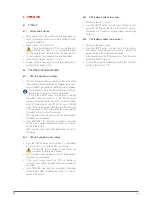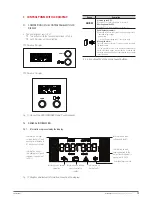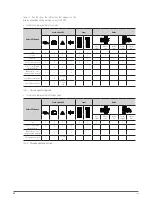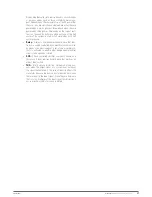
16
SALICRU
Model
Rated
voltage of
batteries
Minimum values,
fast type fuses
DC voltage (V)
Current (A)
SPS 1000 ADV T
(12 v x 2 ) = 24 v
125
50
SPS 1500 ADV T
63
SPS 2000 ADV T
100
SPS 3000 ADV T
(12 v x 4 ) = 48 v
63
Tab. 3.
Protection features between device and battery module.
•
before starting the connection process between the
battery module or modules and the device, check
that the UPS and the loads are set to ‘off’ and that the bat-
tery voltage of all of them is the same, without exceptions.
Also, when the batteries are installed by the user indepen-
dently, the protection fuse or isolator must be deactivated.
•
Connection of the battery module to the UPS is made by
means of a cable featuring polarised connectors at both
ends and supplied with the first one.
Plug the connector at one end of the cable into the corre-
sponding socket on the SPS AdvAnCe T and the one on the
other end into the battery module (see fig. 8).
In the same way, battery modules can be linked in parallel
since each of them has two connectors.
All of the connectors must be secured to their units by
means of the screws that held the protective cover of each
connector to the UPS or battery module.
•
each battery module is independent for each device.
Two devices must not be connected to the
same battery module
.
•
fig. 8 shows, by way of example, the connection of a 3 kvA
device to two battery modules. for a larger number, pro-
ceed in a manner similar to those shown in the illustration.
Fig. 8.
Connection to battery modules.
5.2.5. Terminals for epo (emergency power off).
•
The UPSs have two terminals for the installation of an ex-
ternal emergency power off (ePo) output button.
•
The device is dispatched from the factory with its ePo cir-
cuit set to closed (nC) by default. In other words, the UPS
will cut the output power supply, emergency power off,
when the circuit is opened:
either by removing the female connector from the socket
where it is inserted. This connector has a cable con-
nected as a jumper that closes the circuit (see fig. 9A).
or by pressing the button external to the device be-
longing to the user installed between the terminals
of the connector (see fig. 9b). The connection on the
button must be in the normally closed contact (nC), so
it will open the circuit when activated.
•
To recover the normal operating state of the UPS, it is
necessary to insert the connector with the jumper in its re-
ceptacle or deactivate the ePo button. The device will be
operational.
A
B
Fig. 9.
Connector for external EPO.
5.2.6. Communication port.
5.2.6.1. RS232 and USb port.
•
The communications line -Com- constitutes a very
low voltage safety circuit. To preserve the quality, it
must be installed separately from other lines carrying dan-
gerous voltages (power distribution line).
•
The RS232 and USb interfaces are useful for the monitoring
software and updating the firmware.
•
It is not possible to use both the RS232 and USb ports at
the same time.
•
The RS232 port consists of the transmission of serial data
in such a way that a large amount of information can be
sent through a 4-wire communication cable.
•
The USb port is compatible with the USb 1.1 protocol for
communication software.
Pin #
Description
Input / Output
2
Txd
output
3
Rxd
Input
4
dTR
output
5
gnd
earth
Tab. 4.
Pinout of DB9 connector, RS232.
Pin #
Signal
1
v bUS-
2
d –
3
d +
4
gnd
Tab. 5.
Pinout of the USB connector.













































